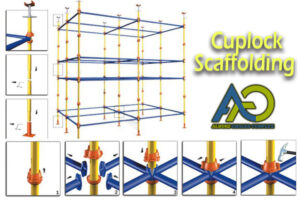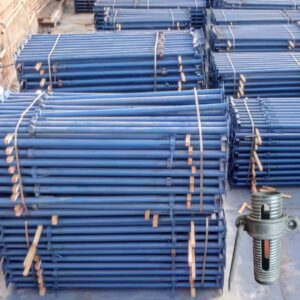Bridge Architecture: Principles and Methods of Foundation and Construction
In this article, we provide a comprehensive exploration of bridge architecture, focusing on the principles of foundation laying, groundwork, and construction methods. This content serves as a specialized guide for enthusiasts of civil engineering and architecture. It has been crafted with SEO (search engine optimization) principles in mind and includes optimized internal linking to deliver valuable insights.
Foundation Laying or Groundwork for Bridges
One of the most critical aspects of constructing bridges and dams is the foundation or groundwork for the bridge piers, particularly when dealing with deep, wide, or high-flow rivers. For this reason, the conditions for laying bridge foundations vary significantly, and engineers have historically employed diverse techniques:
A) Utilizing Fords in Foundation Laying
In some rivers, there are areas where the riverbed is wide, and the water flow is typically calm. These locations, known as “fords,” allow passage on horseback, camel, or mule during non-flood seasons. When constructing major roadways that intersected rivers, engineers often sought to utilize these fords for bridge construction whenever possible.
- In Summer: If the riverbed dried up during summer, most challenges were resolved, and foundation digging proceeded conventionally.
- During High Water: If the river still had flowing water even in low seasons, engineers diverted its course by digging a temporary channel during periods of reduced flow. They then built the bridge pier on the natural riverbed path and, once completed, redirected the water back to its original course. This method was preferred in Iran due to its simplicity.
- In Contrast, in the West: A different approach was taken—engineers constructed a diversion canal, built the bridge over it, and then redirected the river from its natural path into the new canal.
- The oldest bridge constructed using this method was the Babylon city bridge over the Euphrates River, built by Nitocris, the second queen of Assyria. She ordered the excavation of an artificial lake, diverted the Euphrates into it, and, once the original riverbed dried, constructed the massive bridge piers. After filling the lake and completing the bridge, the river was returned to its natural path.
- In Iran, this technique was also used for the foundation of the Shadravan bridge-dam in Shushtar. Dehkhoda provides an interesting account in his dictionary:
Caesar summoned engineers and architects from Rome and the West with vast resources. Initially, they created a breach beneath a mountain—where the shrine of Seyyed Mohammad Giyakhwar is located, and the river flowed westward toward the city—to redirect the water southward. From beneath this mountain to the Caesar Dam, a distance of twelve leagues, they constructed a conduit and channeled the water there. They mixed lime and plaster with sheep’s milk, used cranes to place large stones, fastened each pair of stones with iron hoops, and paved the area from the Mafarian entrance to beneath the bridge with level stonework. They sealed the stone joints with molten lead and built a weir as wide as the river. Then, they constructed a sturdy bridge for easy passage, sealing the breaches beneath the shrine with the same lime and lead mixture until the Shadravan and Mizan Dam were complete. Finally, they redirected the water to its desired course.
According to Ibn Balkhi’s
Farsnameh, regarding the construction of the Amir bridge-dam: Before building the dam, they diverted the water from both sides of the river. Then, they paved the riverbed at the dam site with large stone blocks and sarooj mortar, constructing the dam on this stone raft foundation.
B) Ingenious Innovations in Foundation Laying
Beyond the methods above, foundation laying sometimes involved remarkable innovations. For example, in constructing the Darband Caucasus bridge (formerly Bab al-Abwab, now Makhachkala), where the river’s swift current was uncontrollable, the piers were built creatively:
Animal hides from large creatures like cows, camels, and donkeys were inflated with air and tied to a wooden frame made of beams and planks. These inflated hides were fastened beneath the frame, which was then launched into the water. The frame was anchored at the pier location to resist the current. The bridge pier was constructed atop this floating platform. As the structure grew heavier, the frame gradually sank, and the mooring ropes were loosened from the sides until the hides rested on the riverbed. The piers were raised to the desired height, after which divers punctured the hides to release the air, securing the frame to the riverbed. This ancient technique is considered a form of compressed-air foundation laying.
C) Foundation Laying with Wells and Caissons
Another groundwork method involved digging a series of wells intermittently across the riverbed and installing caissons. These wells were filled with lime mortar and sarooj. The process involved placing a caisson (a wooden or metal tube) in the riverbed and removing sand, mud, and silt from inside it. The caisson sank under its own weight, and additional caissons were stacked atop it until the desired depth was reached. These wells then served as the bridge’s foundation. It is said that the foundations of the Si-o-Se Pol and Marnan bridges in Isfahan were built this way.
Sometimes, wooden caissons were used: sharpened wooden stakes, known as “piles,” were driven into the riverbed, connected with planks, and sealed with mud or tar. The water inside was drained, and the piers were constructed with rubble stones and dressed stone facades.
Bed Preparation for Bridges
The second critical stage after foundation laying was reinforcing the riverbed around the piers and foundations. Engineers and architects with a broader vision of bridge durability paid special attention to this step. Accordingly, beneath some bridges, the riverbed was paved with a gentle slope aligned with the water flow. This was significant for two reasons:
-
- The water flowed smoothly, and the gentle slope allowed mud, silt, and sand to pass under the bridge at an optimal speed, preventing sediment buildup around the piers.
- It prevented erosion of the riverbed beneath the bridge arches, reducing the risk of damage to the piers.
The most notable example of bed preparation can be seen in the Shadravan bridge:
They paved the area from the Mafarian entrance to beneath the bridge at a uniform level and sealed the stone joints with molten lead.
Similar examples of bed preparation are evident in the Cham-Namasht bridge, Dezful bridge, and other Sassanid and Islamic-era bridges.
Modern Tools in Bridge Construction
Today, the use of modern tools like
concrete formwork and
construction prop jacks in bridge projects has significantly enhanced precision and speed. These tools play a key role, especially in constructing piers and arches, replacing traditional methods.
Conclusion
Bridge architecture exemplifies a fusion of art and engineering, enabling safe river crossings through diverse foundation and bed preparation techniques. From utilizing fords and diversion channels to creative innovations and modern tools like
concrete formwork and
prop jacks, each method reflects the ingenuity and expertise of engineers throughout history. For more information on construction equipment, visit the linked pages.







